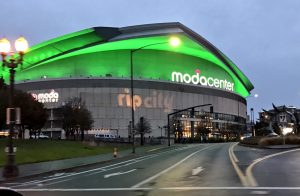Portland Trail Blazers Put Networked Audio Through the Hoops
The NBA has been ahead of the curve when it comes to AoIP
Story Highlights
Although the focus has been on the migration of sports-television broadcasts to IP, sports radio, in many cases, is already there, tapping its foot and wondering what’s taking TV so long. About five years ago, the NBA eliminated the dedicated ISDN T1 lines it had used for more than a decade to interconnect the audio between its venues, replacing that infrastructure with an L3-provided 1.5-MB circuit with dedicated Comrex codecs, a network that each of the league’s 30 arenas could tap into.
Although many of the earliest adopters used the CobraNet networking standard, most have since moved to Dante-enabled networks. The Portland Trail Blazers have been at this since networking first made its presence felt in the NBA and have been using Wheatstone’s WheatNet protocol, which, says Mike Janes, VP, engineering and technology, for the Trail Blazers and their Moda Center home, offered a perfect fit with the Wheatstone L-8 IP console that the team has used for several years as the radio desk and mixer for its radio network’s 25 affiliate stations.

The Trail Blazers’ home in downtown Portland is linked via Dante-enabled WheatNet on a dedicated VLAN to the iHeart Radio flagship station and affiliates.
“We use the Tieline Genie codec with WheatNet to deliver multiple unicast [signals] over AoIP to our affiliates,” he explains. “The ISDN technology actually worked very well, but it got to a point some years ago that it was harder to get a reliable ISDN line. So we moved onto a network, and now all of the arenas are connected using the Comrex BRIC codecs. Just within the stadium and our radio network, we’re also using [Dante-enabled] WheatNet on a dedicated VLAN over a single strand of fiber back to the iHeart Radio flagship station as well as to the affiliates.”
The Trail Blazers were able to buy into a city-core dark-fiber network installed by a consortium of healthcare, financial, and other local industries; some broadcasters in cities that have invested in municipal network infrastructure, such as Austin, TX, have taken advantage of the same strategy.
Janes says the WheatNet network also fits well with the Wheatstone E6 console used at the flagship station, where one of Wheatstone’s BLADE “smart” I/O units with integrated CPU and OS was dedicated as an I/O for the arena’s AoIP output, traversing about 14 miles over fiber.
Video over IP is still getting traction for the television broadcasts, according to Janes. The Trail Blazers’ SSL C100 HDS audio console is networked via a MADI bridge from the console to a Dante bridge into the network. A similar arrangement connects the console to the arena’s RTS intercom matrix for IFB, program feeds, and other signals.
On the radio side, he adds, the NBA has been pushing the envelope for networked audio for some time, although radio tends to be overshadowed by its television sibling.
“Audio is certainly the most complicated and underappreciated aspects of what we do,” he says. “Just not everyone hears about it.”
